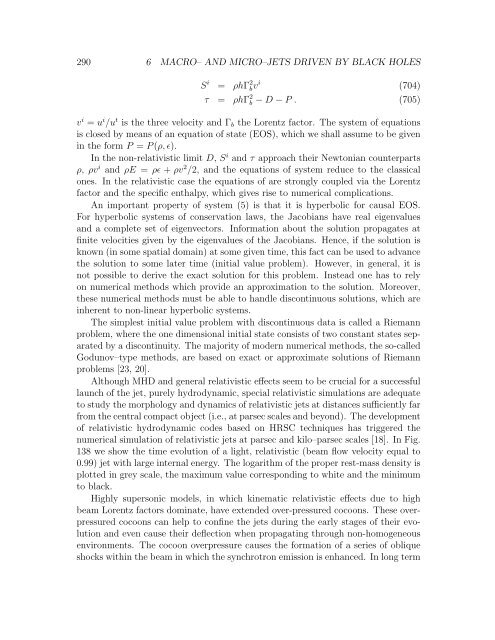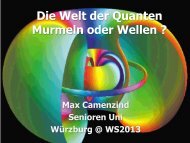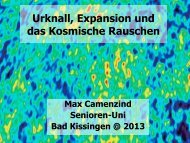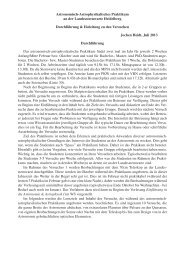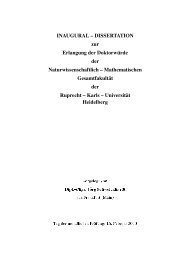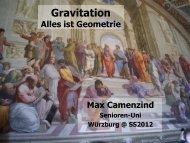Contents List of Figures
Contents List of Figures
Contents List of Figures
Create successful ePaper yourself
Turn your PDF publications into a flip-book with our unique Google optimized e-Paper software.
290 6 MACRO– AND MICRO–JETS DRIVEN BY BLACK HOLES<br />
S i = ρhΓ 2 bv i<br />
(704)<br />
τ = ρhΓ 2 b − D − P . (705)<br />
v i = u i /u t is the three velocity and Γb the Lorentz factor. The system <strong>of</strong> equations<br />
is closed by means <strong>of</strong> an equation <strong>of</strong> state (EOS), which we shall assume to be given<br />
in the form P = P (ρ, ɛ).<br />
In the non-relativistic limit D, S i and τ approach their Newtonian counterparts<br />
ρ, ρv i and ρE = ρɛ + ρv 2 /2, and the equations <strong>of</strong> system reduce to the classical<br />
ones. In the relativistic case the equations <strong>of</strong> are strongly coupled via the Lorentz<br />
factor and the specific enthalpy, which gives rise to numerical complications.<br />
An important property <strong>of</strong> system (5) is that it is hyperbolic for causal EOS.<br />
For hyperbolic systems <strong>of</strong> conservation laws, the Jacobians have real eigenvalues<br />
and a complete set <strong>of</strong> eigenvectors. Information about the solution propagates at<br />
finite velocities given by the eigenvalues <strong>of</strong> the Jacobians. Hence, if the solution is<br />
known (in some spatial domain) at some given time, this fact can be used to advance<br />
the solution to some later time (initial value problem). However, in general, it is<br />
not possible to derive the exact solution for this problem. Instead one has to rely<br />
on numerical methods which provide an approximation to the solution. Moreover,<br />
these numerical methods must be able to handle discontinuous solutions, which are<br />
inherent to non-linear hyperbolic systems.<br />
The simplest initial value problem with discontinuous data is called a Riemann<br />
problem, where the one dimensional initial state consists <strong>of</strong> two constant states separated<br />
by a discontinuity. The majority <strong>of</strong> modern numerical methods, the so-called<br />
Godunov–type methods, are based on exact or approximate solutions <strong>of</strong> Riemann<br />
problems [23, 20].<br />
Although MHD and general relativistic effects seem to be crucial for a successful<br />
launch <strong>of</strong> the jet, purely hydrodynamic, special relativistic simulations are adequate<br />
to study the morphology and dynamics <strong>of</strong> relativistic jets at distances sufficiently far<br />
from the central compact object (i.e., at parsec scales and beyond). The development<br />
<strong>of</strong> relativistic hydrodynamic codes based on HRSC techniques has triggered the<br />
numerical simulation <strong>of</strong> relativistic jets at parsec and kilo–parsec scales [18]. In Fig.<br />
138 we show the time evolution <strong>of</strong> a light, relativistic (beam flow velocity equal to<br />
0.99) jet with large internal energy. The logarithm <strong>of</strong> the proper rest-mass density is<br />
plotted in grey scale, the maximum value corresponding to white and the minimum<br />
to black.<br />
Highly supersonic models, in which kinematic relativistic effects due to high<br />
beam Lorentz factors dominate, have extended over-pressured cocoons. These overpressured<br />
cocoons can help to confine the jets during the early stages <strong>of</strong> their evolution<br />
and even cause their deflection when propagating through non-homogeneous<br />
environments. The cocoon overpressure causes the formation <strong>of</strong> a series <strong>of</strong> oblique<br />
shocks within the beam in which the synchrotron emission is enhanced. In long term


